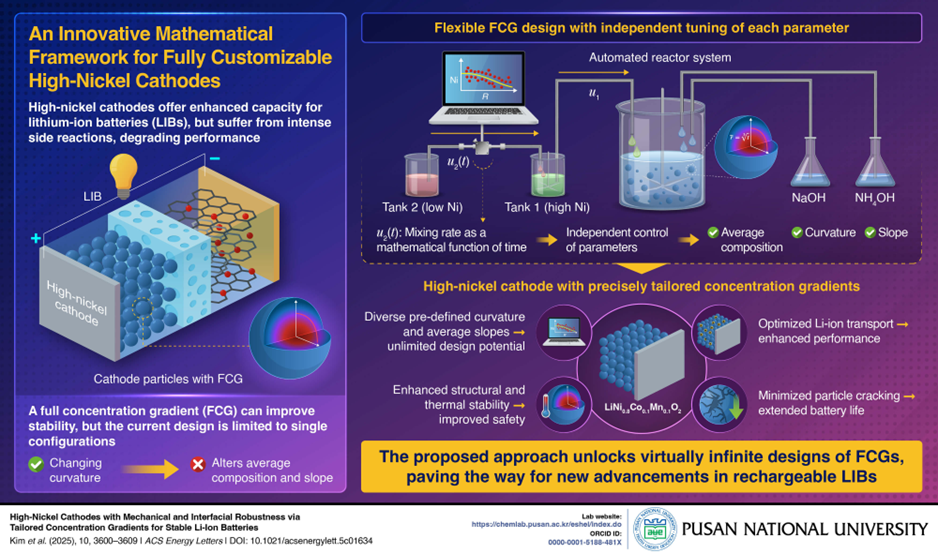
Game-Changing Method to Create Safer, Long-Lasting Lithium-Ion Batteries
A novel mathematical x-framework unlocks unlimited customization of full concentration gradient in high-nickel cathodes for improved safety and stability
High-nickel cathodes are promising for improving the energy density of lithium-ion batteries (LIBs). However, their high nickel concentration leads to intense side reactions, degrading safety and stability. While full concentration gradient (FCG) design can address this issue, current approaches limit design flexibility. Now, researchers have developed a novel mathematical x-framework that, combined with an automated reactor system, allows unlimited customization of FCGs with independent parameter control, leading to LIBs with enhanced safety and stability.

Image title: Proposed mathematical approach for unlimited customization of full concentration gradients
Image caption: The proposed approach allows precise and independent control of average composition, slope, and curvature of full concentration gradients in high-nickel cathodes, resulting in lithium-ion batteries with improved performance, stability, and safety.
Image credit: Hyun Deog Yoo from Pusan National University
License type: Original Content
Usage restrictions: Cannot be reused without permission
With the recent global push toward renewable energy and electric vehicles, the demand for lithium-ion batteries (LIBs) is rising rapidly. The performance and stability of LIBs largely depend on the cathode material, which can account for nearly 40–45% of the total battery cost. Among cutting-edge technologies, high-nickel cathodes stand out for their high energy density and cost efficiency. However, increasing the nickel content also intensifies side reactions, severely compromising interfacial robustness and mechanical integrity—factors that limit large-scale applications.
A promising solution is the use of full concentration gradient (FCG) or core–shell designs. In such structures, the nickel concentration gradually decreases from the core to the surface of each cathode particle, where it is replaced by more stable elements such as cobalt and manganese. This gradient enhances surface stability and mechanical strength. Unfortunately, the current fabrication methods offer limited tunability. Once the average composition is set, the slope and curvature of the gradient are also constrained, restricting the design flexibility of FCG cathodes.
In a new study, an international research team led by Associate Professor Hyun Deog Yoo from the Department of Chemistry and the Institute for Future Earth at Pusan National University, Korea, introduced a novel mathematical x-framework that enables fully flexible FCG design. “Unlike conventional methods, where adjusting one parameter affects the others, our approach allows independent and precise control over multiple descriptors, including average composition, slope, and curvature,” explains Dr. Yoo. The team’s findings were published on June 30, 2025, in the journal ACS Energy Letters.
Traditionally, FCG cathodes are synthesized via a coprecipitation method involving two tanks of metal precursor solutions. The first tank, rich in nickel (Ni), feeds directly into the reactor. The second tank, containing cobalt (Co) and manganese (Mn), is mixed into the first to reduce the Ni concentration over time. In conventional systems, the flow rate of this second tank is fixed, meaning only one specific gradient can be achieved for a given average composition.
The researchers overcame this limitation by expressing the flow rate of the second tank as a time-dependent mathematical function. This innovation allows independent tuning of the average composition, slope, and curvature—enabling the generation of a virtually unlimited range of concentration gradients using just two tanks. By integrating this approach with an automated reactor system, the team successfully synthesized five FCG Ni0.8Co0.1Mn0.1(OH)2 precursors with finely tuned gradients, verified through two- and three-dimensional elemental mapping.
“For this purpose, we assembled an outstanding international research team, collaborating with laboratories at the University of Illinois Chicago, Argonne National Laboratory, and several institutes across Korea and the United States,” says Dr. Yoo. “My lab focused on designing and synthesizing FCG cathodes, while most of the 2D and 3D imaging analyses were conducted by the groups of Prof. Jordi Cabana and Prof. Robert F. Klie. We feel truly privileged to have been part of such a remarkable collaboration.”
The resulting high-nickel cathodes exhibited significantly improved mechanical and structural stability compared to conventional counterparts. They showed enhanced lithium-ion transport for better electrochemical performance and minimal particle cracking—an essential trait for long cycle life. Notably, the optimally designed FCG cathode retained 93.6% of its initial capacity after 300 cycles, the highest cycling stability reported for FCG cathodes of similar composition.
“Our approach has the potential to transform the safety and performance of LIB-based energy storage systems,” says Dr. Yoo. “This could lead to safer consumer electronics and medical devices, more reliable electric vehicles, stable power grids, and broader adoption of renewable energy technologies.”
This work was supported by the Sustainable Utilization of Photovoltaic Energy Research (SUPER) Center, led by Prof. Sung-Ho Jin, under the Engineering Research Center (ERC) program funded by the National Research Foundation of Korea.
Reference
Title of original paper: High-nickel cathodes with mechanical and interfacial robustness via tailored concentration gradients for stable Li-ion batteries
Journal: ACS Energy Letters
DOI: 10.1021/acsenergylett.5c01634
About Dr. Hyun Deog Yoo
Dr. Hyun Deog Yoo is an Associate Professor of Chemistry at Pusan National University. His research centers on advanced materials for energy storage, with a particular emphasis on lithium-ion and magnesium-ion batteries. The Yoo group adopts a comprehensive approach, integrating materials synthesis, electrochemical analysis, and computational modeling to delve into ion transport and interfacial phenomena. He completed his Ph.D. in Chemical and Biological Engineering from Seoul National University in 2011, followed by postdoctoral training at Bar-Ilan University, the University of Houston, and the University of Illinois Chicago.
Lab website: https://chemlab.pusan.ac.kr/eshel/index.do
ORCID Id: 0000-0001-5188-481X
 PURCS_158_Infographics_final.jpg
(741KB)
PURCS_158_Infographics_final.jpg
(741KB)